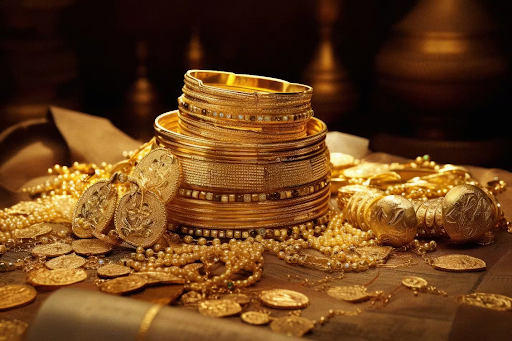Gold has remained one of the most sought-after commodities for centuries due to its intrinsic value, versatility, and universal appeal as a symbol of wealth and prosperity.
If you’ve ever delved into the gold market, whether as a buyer, investor, or collector, you’ve likely encountered measurements like “1 oz gold” or grams when discussing weight and pricing. Understanding how 1 oz gold to grams conversion works can significantly impact your decision-making process when buying gold.
Additionally, it’s crucial to know how many types of gold exist to make better purchasing choices tailored to your needs. In this article, we’ll explore the importance of accurately converting gold weight from ounces to grams and discuss the various types of gold buyers encounter in the market.
Understanding 1 Oz Gold to Grams Conversion
When buying gold, weight matters. Gold is typically measured in troy ounces instead of regular (avoirdupois) ounces, and these measurements can be confusing if you’re unfamiliar with the distinctions.
What Is a Troy Ounce?
The troy ounce is a unit of weight specifically used for precious metals like gold, silver, and platinum. It differs from the standard ounce most people use for everyday measurements. One troy ounce is equivalent to 31.1035 grams, while one regular ounce is equivalent to 28.3495 grams.
1 Oz Gold to Grams Conversion
Buyers and investors often ask, How much is 1 oz gold to grams? As noted above, 1 troy ounce = 31.1035 grams. This is the universally accepted standard for measuring gold. If you’re considering buying gold in bulk, understanding this conversion is critical for calculating the weight and value accurately.
For example:
- A gold coin weighing 1 oz troy has a weight of exactly 31.1035 grams.
- Similarly, if you have gold weights expressed in grams, you can convert them back to troy ounces by dividing by 31.1035.
Why 1 Oz Gold to Grams Conversion Matters
1. Accurate Pricing
Gold prices are typically quoted per ounce or per gram in financial markets. If you don’t understand the nuances between ounces and grams, you risk being misled or misunderstanding the gold’s true value. For example, if the current market price of gold is $1,800 per troy ounce, you’ll need to use the proper conversion rate to calculate the equivalent value in grams ($1,800 ÷ 31.1035). This ensures transparency when comparing products from different dealers.
2. International Transactions
Gold is a universally traded commodity, but countries use different metrics for measuring gold. While the troy ounce is standard globally, many buyers prefer dealing in grams, especially in regions where the metric system is dominant. This makes knowing the 1 oz gold to grams conversion even more critical for seamless trades across borders.
3. Avoiding Fraud
Understanding how much gold weighs ensures that you’re buying genuine products. Untrustworthy sellers might misrepresent the weight of gold items to inflate value. When you know exactly how much 1 oz gold equals in grams, you can verify the product weight before making purchases and ensure fairness.
4. Ease of Comparisons
Whether you’re purchasing gold bars, coins, or jewelry, weight-based comparisons become straightforward when you switch between ounces and grams. Grams are generally easier for individuals accustomed to metric systems, while ounces are favored by investors in Western countries. Converting ensures you’re comparing apples to apples, not apples to oranges.
How Many Types of Gold Are There?
When people talk about gold, they often think of a shiny yellow metal. However, gold for buyers actually comes in a variety of forms, finishes, and purities. Understanding how many types of gold exist can help buyers choose the best option suited to their needs and preferences.
1. Gold Purity Levels
Gold purity is categorized into different karats, and it dictates how much actual gold vs. alloy is present in the material.
24K Gold
- Purity: 99.9% pure gold
- Characteristics: Soft and malleable
- Applications: Best for investment purposes in coins or bars. Rarely used in jewelry due to its softness.
22K Gold
- Purity: 91.6% pure gold mixed with other metals like copper or silver
- Characteristics: Stronger than 24K gold while maintaining a rich yellow color
- Applications: Common in gold jewelry, especially in India and Southeast Asia.
18K Gold
- Purity: 75% pure gold
- Characteristics: Balanced durability and aesthetic appeal, less prone to scratching
- Applications: Ideal for high-end jewelry like rings, necklaces, and bracelets.
14K Gold
- Purity: 58.3% gold
- Applications: Widely used for affordable jewelry, particularly in the U.S.
10K Gold
- Purity: 41.7% gold
- Applications: Budget-friendly jewelry but not recommended for investment.
2. Gold Forms
Gold comes in different physical forms, tailor-made for various buyers ranging from investors to casual consumers.
Gold Bars
Gold bars (or ingots) are ideal for investors seeking large quantities of pure gold. These bars are typically branded, stamped with their weight and purity, and measured in either ounces or grams.
Gold Coins
Gold coins are popular among both investors and collectors. Some coins, like the American Gold Eagle or Canadian Maple Leaf, are made from high-purity gold and are valued based on both the gold content and their rarity.
Gold Jewelry
Jewelry is one of the most common types of gold purchases. It offers buyers both beauty and value, though its worth also depends on craftsmanship, design, and market demand.
Gold Dust
Although rarer for buyers, gold dust is raw gold collected during mining operations. It’s typically traded in bulk and refined into bars or other products.
3. Gold Colors
The color of gold depends on the alloys mixed with the material. While yellow gold is the most popular, other variations exist:
Yellow Gold
Yellow gold is the “classic” gold color, often used in 18K or 24K gold jewelry. It offers timeless appeal.
White Gold
White gold contains a mix of gold and platinum or palladium for a silvery-white appearance. It’s popular for modern jewelry and engagement rings.
Rose Gold
Rose gold incorporates copper to create a pinkish hue. It’s stylish and trendy, especially in fashion-forward jewelry designs.
Green Gold
Green gold combines gold and silver for a pale greenish color. It’s less common but still striking.
Investment vs. Personal Use: Why Gold Buyers Should Know Their Options
Whether you’re buying gold for investment or personal use, knowing the types of gold and how gold weight works directly impacts your purchasing decisions.
Investment Purposes
For investors, purity and weight matter most. Items like gold bars and coins with clear markings of weight (e.g., 1 oz gold or 31.1035 grams) give confidence in their resale value. You must also know how 1 oz gold to grams conversion works to verify the product’s weight matches the quoted price.
Personal Consumption
When buying gold jewelry or decorative items, karat levels and craftsmanship take precedence over weight. However, you’ll still benefit from understanding weight measurements, especially when comparing items priced by the gram vs. item designs.
Tips for Smart Gold Buying
1. Always Verify the Weight
Whether the gold is listed in ounces or grams, use the standard 1 oz = 31.1035 grams conversion to validate its accuracy.
2. Understand Purity Levels
Choose gold of appropriate purity depending on your purpose. Higher karats work better for investments, while mid-range karats (18K or 14K) are ideal for jewelry.
3. Research the Gold Dealer
Ensure you buy gold from a reputable dealer who provides accurate weight and purity details.
4. Monitor Market Prices
Gold prices fluctuate regularly. Stay updated on the price per troy ounce to ensure you’re buying or selling gold at optimal value.
Conclusion: Why 1 Oz Gold to Grams Matters When Buying Gold
Gold is a universal commodity, and understanding the basics like 1 oz gold to grams conversion plays a vital role in ensuring you’re making informed decisions. Whether buying gold as an investment, collecting coins, or purchasing jewelry, knowing how different types of gold and their measurements interact can save you money and maximize value. By mastering the 1 oz = 31.1035 grams conversion and educating yourself on gold’s types, you can confidently navigate the gold market and avoid common pitfalls. So the next time you hear the phrase “1 oz gold,” you’ll know exactly what it means in grams—empowering yourself to make smart, strategic purchases in a highly competitive market!





